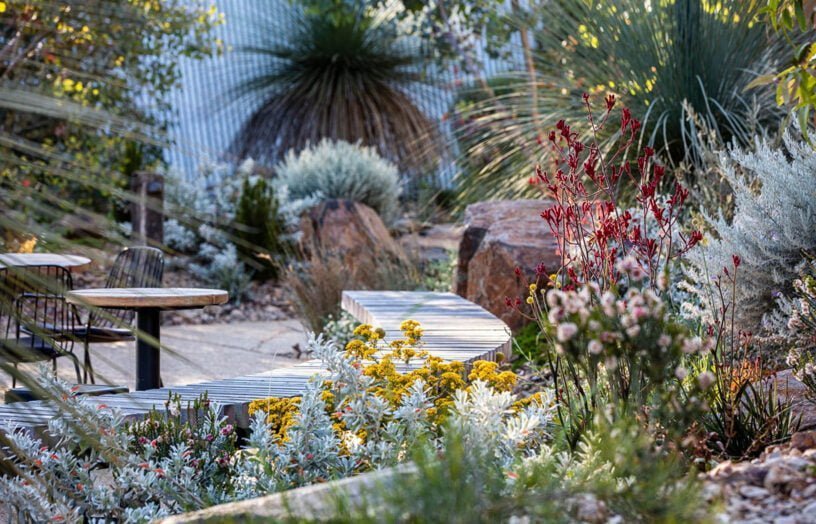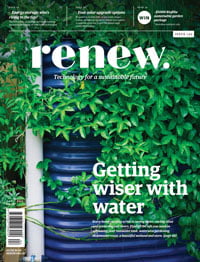Stormwater reuse for parks and whole cities
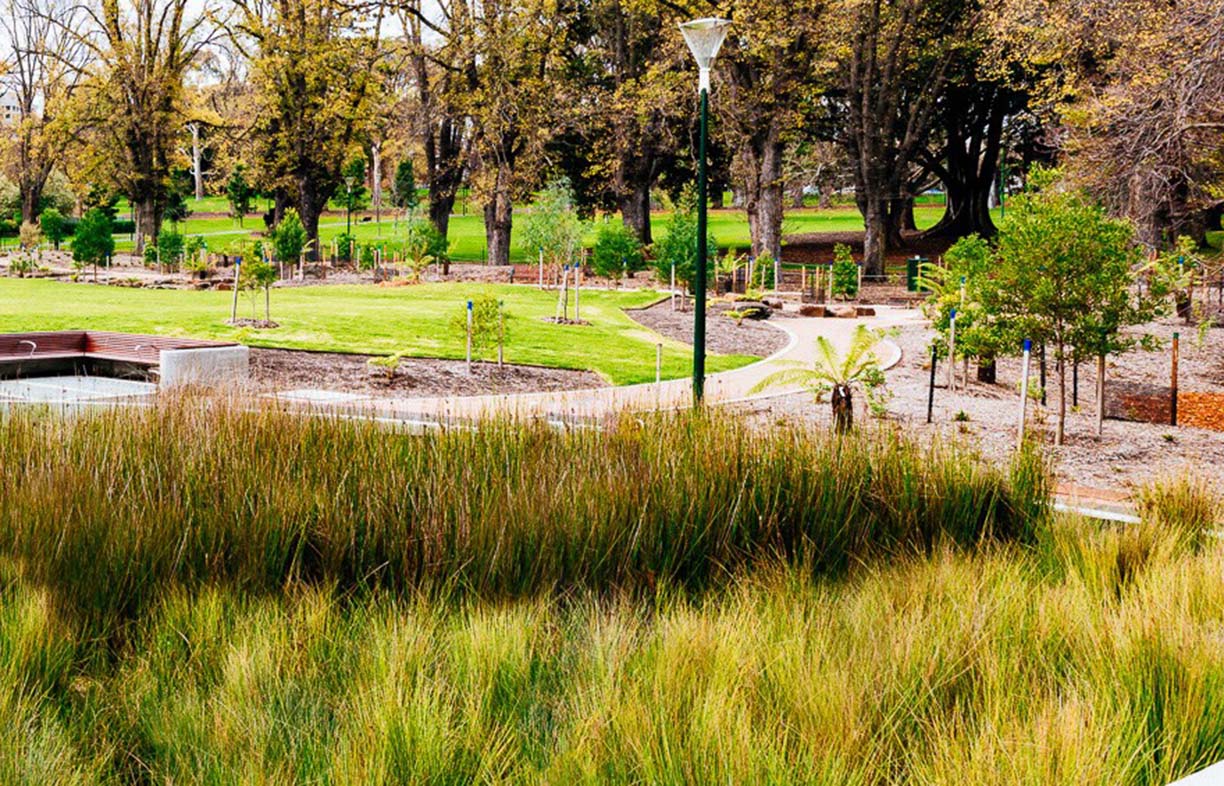
If we change our approach, stormwater can provide water for irrigation, and even drinking. Jodie Lea Martire explores projects around Australia, including some in your own backyard.
Australia is ranked as the 17th most water-stressed nation in the world, yet Stormwater Australia estimates that around 3000 GL of stormwater runs off our urban areas each year, greater than the volume of potable water consumed. This runoff poses two main issues: 1) it is a wasted resource, and 2) the pollutants it carries degrade our waterways.
Currently, up to 90% of rainwater falls on hard surfaces in our cities and is drained into waterways without treatment, carrying pollutants like rubbish, earth, organic matter, heavy metals (copper, lead and zinc), grease and oil (from roads), fertilisers (from gardens), and dissolved nutrients like salts, phosphorous and nitrogen. Unmanaged flows can result in localised urban flooding in high rains and also overburden creeks and rivers whose seasonal water cycles are disrupted.
Minimising and managing cities’ stormwater can improve both resource waste and waterway pollution, potentially supplying around 265 kL of water per household per year. Australian cities are leaders in the field. Ralf Pfleiderer, of Stormwater Victoria , says, “Australian cities do look internationally for stormwater solutions, but we don’t find people doing similar things. It’s something we should be quite proud of.”
A first line of response among city councils is to promote domestic rainwater harvesting by subsidising or mandating the installation of home rainwater tanks, to ‘bank’ water for gardens or toilet flushing in dry periods and to slow public stormwater flows during rains. Another popular strategy is the raingarden; these are mini-wetlands—often planted with native vegetation—which divert and filter rainfall rather than letting it flow untreated into street stormwater. Over 6.7 million Australian homes have a garden, so to tap the water-management potential many councils and water authorities have issued guidelines for creating domestic raingardens.
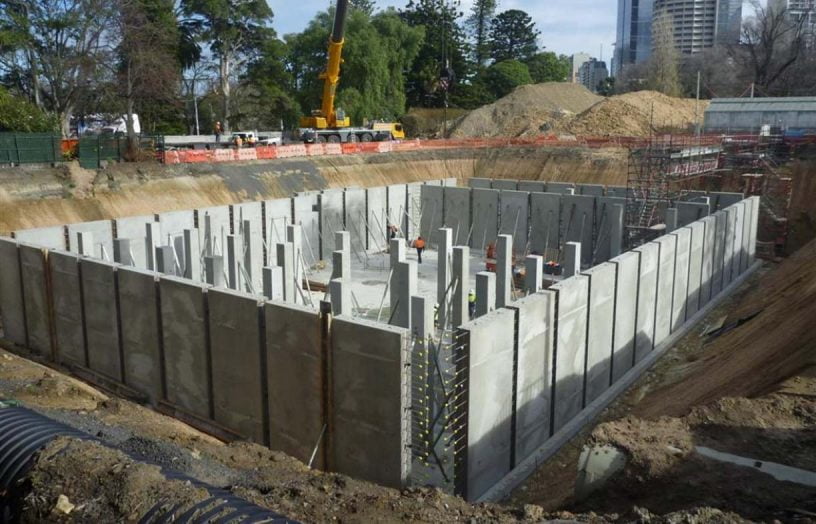
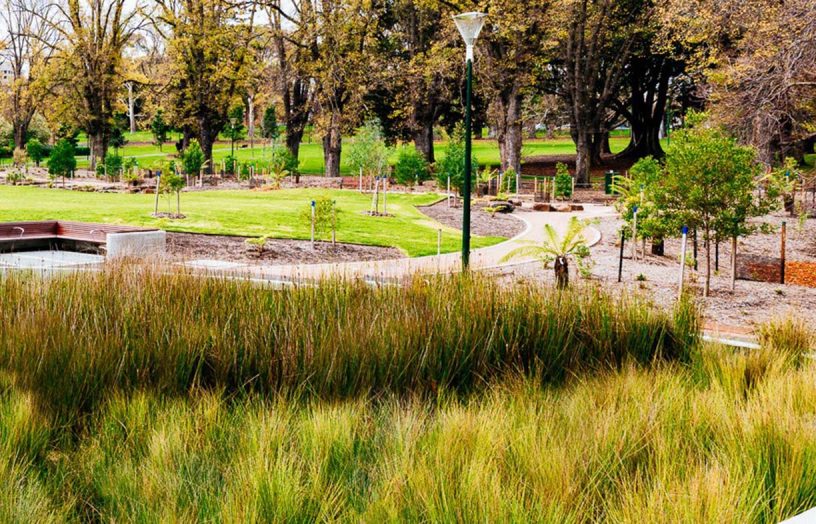
The raingarden concept also operates in large-scale urban installations. One Melbourne example is the Fitzroy Gardens Stormwater Harvesting System (see also Renew 121 and 135), whose compact design uses wetland principles and vast storage tanks (4 million and 1 million litres) under an inner-city park. Stormwater is collected from the 67 hectares of surrounding catchment, and litter and large waste are caught in a gross pollutant trap. The water is then stripped of sands and oils in a sedimentation chamber, temporarily stored in the larger tank and passed through a biofiltration bed (the wetland part) to strip nitrogen and phosphorous. It’s stored in the smaller tank before being disinfected with UV light to rid it of bacteria and viruses, then it is sprayed over the gardens at night to minimise any potential health risk to park users. It has been operating since December 2013 and uses around 30 to 50 million litres of stormwater for irrigation each year.
There have been some issues over the almost five years of the system’s operation. The design uses water pumps differently to most other projects, so pumps fail often and can be difficult to fix. The issue is improving over time, as it has been a question of finding suitable pumps and getting them installed and maintained correctly on the ground. In all the irrigation systems, the sprinkler times have also been changed to run more frequently for a shorter time—this uses less water, keeps better soil moisture while slowing runoff time back into the catchment, and improves vegetation health.
Large-scale raingarden-type systems are now regularly being implemented in outlying suburbs, where land is not at such a premium and the attractive water features are a highlight of the design. The Victorian housing developments of Waterways (Mordialloc), Mernda Villages (Epping) and Wandana (Geelong) are among many others all benefitting from incorporated wetland systems. Capturing and reusing the stormwater, according to Ralf Pfleiderer, imitates a forested catchment, where most water is absorbed and only a little runs off.
In an Australian first, the city of Orange (pop. 40,000) has implemented a scheme that can supply 25% of its drinking water by harvesting and treating stormwater from urban areas. The millennium drought from 2001 to 2009 had devastated its town-water dams, with levels sinking to 23% capacity in May 2010. After brainstorming by the city council and consultant Geolyse, a plan for stormwater harvesting began in November 2007, when the city was already at Level 5 water restrictions. The scheme harvested its first stormwater in April 2009.
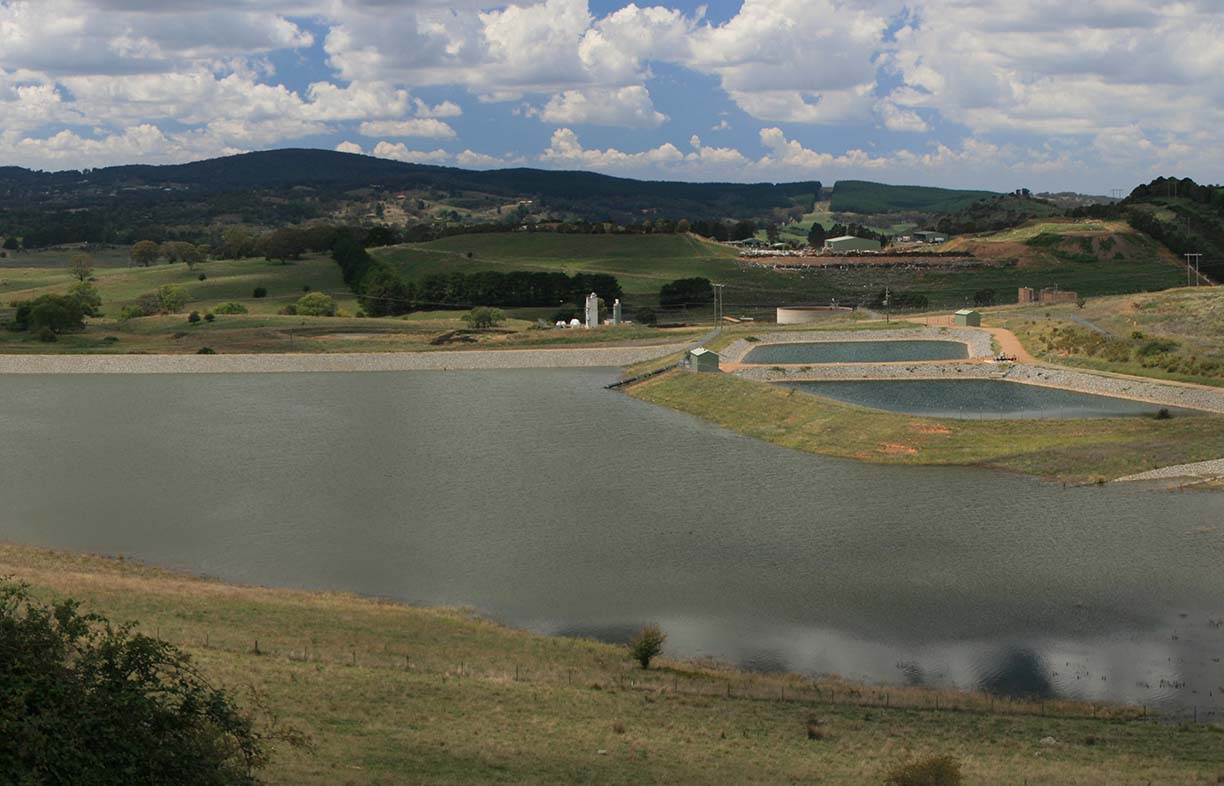
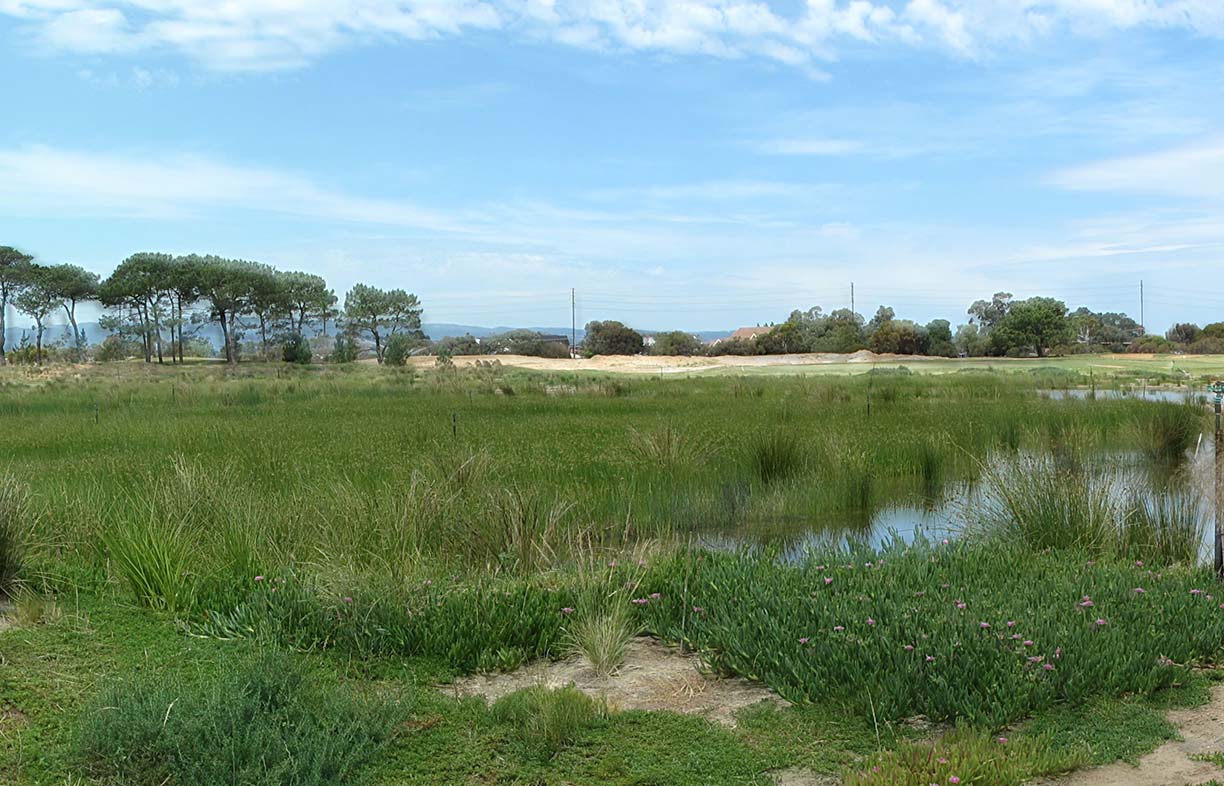
Stormwater is captured from two catchments, one using a rock-and-gabion weir and the other a series of constructed wetlands, and pumped to a 230 ML holding pond then into batch ponds where it is treated with the coagulant polyaluminium chlorohydrate to remove solids and contaminants; it is then transferred to Orange’s main water supply dam. The blended water is treated at the existing treatment plant where it is passed through conventional flocculation, sedimentation and filtration processes, and treated using ozonation, biological activated carbon filters and chlorine. The project can potentially harvest 1350 ML per year. Orange’s community was very willing to participate, because the city’s water supply was at such critical levels. Test results indicate that the treated stormwater is consistently better quality than Orange’s surface water sources.
This reuse option may not currently be viable everywhere in Australia. The Aura development on the Gold Coast, a masterplanned community for 48,000 residents, commenced construction in 2015. It considered the stormwater-to-potable path but was unable to pursue it because of gaps in Queensland’s regulatory framework.
Adelaide has devised some particularly creative solutions to ensure its water supply. Wells drilled 20 m to 100 m into below-ground aquifers have long provided year-round potable or irrigation water, but about 30 years ago a new use for them was devised. According to Sam Phillips, of Natural Resources Adelaide and Mt Lofty Ranges, “People had been extracting groundwater, then they realised that you could also reverse the pumps and squirt water back into the aquifers and store it there.” This is the essence of managed aquifer recharge (MAR). South Australia currently has 60 schemes in operation, which collect and filter water before it’s pumped into an aquifer storage and recovery well, where it forms a ‘bubble’ around the bore that can be drawn and used for irrigation come summer.
The MAR installations at the Glenelg, Grange and Royal Adelaide golf clubs have been operating successfully since 2011 (Glenelg) and 2009 (others). Collectively they save almost 1000 million litres of water annually. The filtering wetlands enhance a golf course’s beauty while treating the stormwater and reducing the salinity of the bores.
MAR can also store and reuse wastewater in the same way: since 2009 the Christies Beach Wastewater Treatment Plant, on Adelaide’s southern coast, has reused 400 ML per year through MAR at its Aldinga site. CSIRO has also been investigating ‘aquifer storage transfer and recovery’, which moves injected water between wells in an aquifer; another possibility is injecting treated stormwater and wastewater into the same bore.
The City of Sydney is due to open the Green Square Water Reuse Scheme in August 2018, which will recycle stormwater for non-potable end-uses in the new town centre of Green Square, located between Sydney’s CBD and the airport. The Green Square community and cultural precinct, plus City West’s affordable housing, will be among the first to receive the recycled water. When at full capacity, the scheme will reuse up to 900 kL of stormwater per day, directed to toilets, laundries, cooling towers, water features and irrigation. It will be harvested through a new underground culvert then filtered (through ultrafiltration), polished (reverse-osmosis membrane systems) and disinfected (sodium hypochlorite) before being stored in two underground 500 kL tanks. All new residential apartments will have dual piping, delivering potable water from Sydney Water separate from purple pipes for the non-potable, harvested water. The recycled water is currently 10c/kL cheaper than potable water.
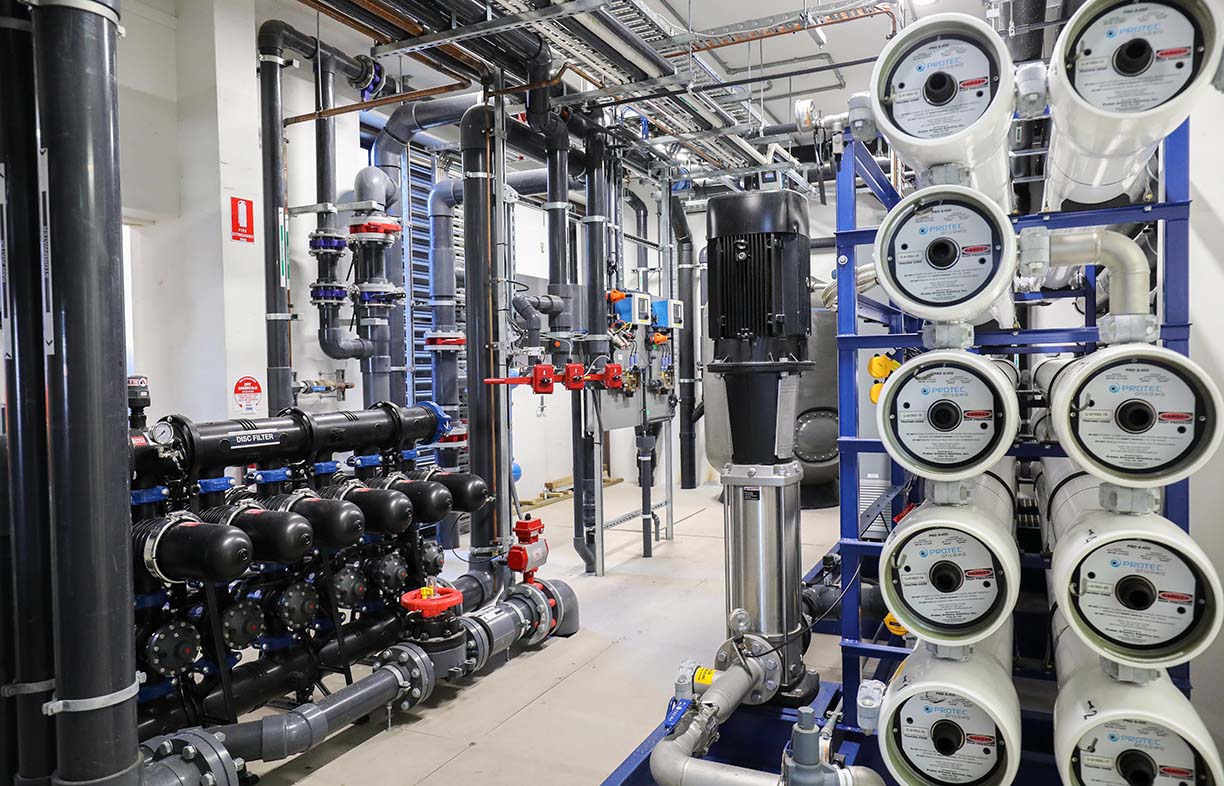
Australia is not the only country to innovate in stormwater capture. One dramatic solution was built in Singapore’s south-eastern Marina Channel. In 2008, the Marina Barrage was opened, damming off seawater access to create a freshwater source for the city. Rainwater was captured in the new Marina Reservoir to desalt the standing saltwater from early 2009, and since late 2010 this operates as a freshwater source which collects stormwater from a 10,000-hectare catchment. In addition, the installation helps prevent flooding in low-lying areas, which is caused by a combination of heavy rain and very high tides. The broader ecological issues require serious consideration in such a high-impact intervention.
Cape Town in South Africa has examples in the town of Atlantis (pop. 61,000), 40 km to the north. Since 1979, the town has provided 30% of its water supply by collecting stormwater and higher-quality treated wastewater for MAR use (as in South Australia). Low-quality water is safely recharged near the coast, creating a hydraulic barrier between groundwater and seawater. Also, in Cape Town’s Liesbeek River Catchment, a small channel was dug in 2014 to connect the Liesbeek with a neighbouring floodplain. At peak flow the excess water flows to the floodplain and converts it to a wetland, recharging the groundwater and reducing flood risks downstream.
We can take our pick of rainwater-tank installations around the world. The semi-arid part of Brazil suffers highly erratic rainfall and is home to around 18 million people. To increase residents’ reliable water supply, in 2003 the One Million Cisterns Project issued homes with rooftop rainwater-harvesting systems. They included gutter, pipe and 16,000 L capacity collection tank, and water was extracted by a manual pump. A Thai project sells inexpensive rainwater collecting jars to households to ensure year-round water supply. Jars come in various capacities (100–3000 L), and include lid (against mosquitoes), tap and drain. A 2000 L jar supplies a six-person household over the tropical dry season, and villagers are trained to make and maintain the jars as a community project.
In Bangladesh, around 20 million people drink arsenic-laced water from groundwater wells. A local NGO has supplied over 1000 rainwater tanks since 1997, ranging in composition across ferro-cement, brick and reinforced concrete ring tanks (stacking concrete rings to the desired tank size). Spreading such projects across Bangladesh could help mitigate the country’s annual, catastrophic floods.
An urban model of stormwater capture and reuse is Brooklyn Grange, a 0.8-hectare farm on two rooftops in the New York boroughs of Queens and Brooklyn. In addition to producing rooftop eggs and honey, the farm has sold over 227 tonnes of organic produce to the public, CSA (community-supported agriculture) members and local restaurants. The roof-farms capture around 7.6 ML of stormwater per year for farm use, and the green roofs also provide heating and cooling benefits to the buildings beneath.
Biofilta, a company involved in the design of the Fitzroy Gardens project, has also been inspired by these urban farm stormwater models. The company has developed modular, wicking (self-watering) garden tubs with the aim of creating household-scale urban farms. The plants in the tub ‘wick’ (draw up) water on demand from a reservoir within each tub, which can be filled by hose or by being plumbed into a rainwater tank or downpipe. Biofilta’s modelling shows that a Melbourne house with 200 m2 roof area and a 10,000 L tank can water a 40 m2 ‘Foodwall’ garden, producing 640 kg of food per year—enough for five adults, saving around $5000 on food bills.
The food-production stats are based on a two-year project with a 10 m2 test garden in a Port Melbourne café, while the water quality was modelled using industry-standard software MUSIC—Model for Urban Stormwater Improvement Conceptualisation. In Biofilta’s Melbourne proposal, the roof area is expected to produce 109,000 L of runoff annually. By directing this runoff through the wicking beds, a Melbourne house exceeds Victoria’s Best Practice Environmental Standards for stormwater treatment, reducing solids by 85.2% (against 80%), nitrogen by 74.1% (against 45%) and phosphorous by 77.1% (also 45%). The system also relies on rainfall 97% of the time, only getting 3% from tap water.
Nationwide, Australia is implementing many ground-breaking stormwater management policies, but we have yet to have a central policy to direct development and regulation. A National Stormwater Initiative was recommended in a 2015 Senate Report, and public consultation has been ongoing, but no policy has yet been announced. In its absence, it is city councils and private businesses who are pushing innovation and solutions in stormwater capture and reuse—including in your own garden.

Wicking beds and rainwater: from roofs to vegies
An existing Biofilta installation which uses rainwater is at Athol Road Primary School, in Melbourne’s south-east, under the care of environmental education teacher Bryan Hunter. Bryan manages extensive gardens which house rabbits, ducks and chickens, and demonstrate various growing techniques—such as vertical, no-dig and aquaponic systems—and now Biofilta’s wicking tubs.
Marc Noyce installed the Biofilta system in two half-days in February 2018, and it was up and running straight away. “The plants were in by March,” Bryan says, “and we were harvesting within five weeks. Sort of like plants on steroids.” The City of Greater Dandenong Community Grants had funded 72 Foodwall bins and the install only had minor issues that were easily solved. “Once it was set up, we could see we weren’t going to have much access [for the kids to plant seedlings]—but we could move bits and pieces around like a giant Jenga.” There was also the odd hose which wasn’t connected tightly between tubs, and one reservoir lid blew off in a heavy storm, but that’s “nothing a bit of duct tape won’t fix.”
The whole garden, including the Biofilta system, is fed by rainwater. The school’s new buildings are hooked to rainwater tanks with 30,000 to 40,000 L capacity; the flow is piped to the timer-controlled irrigation systems, and the wicking tubs are filled from the tank hose. Bryan says he filled the tubs’ reservoirs on the last day of Term 1, left it for two weeks, and just had to top up the system when he returned to school: “Plug it in and give it 10 to 15 minutes, and you’re done for watering—crazy!” He’s also seen a decrease in weeding.
Overall, Bryan says, “The system is amazing, I’d recommend it to any school or anywhere that wants to be water conscious. It’s really good in a school setting, with weekends and holidays, as it’s almost water free.”
Further reading
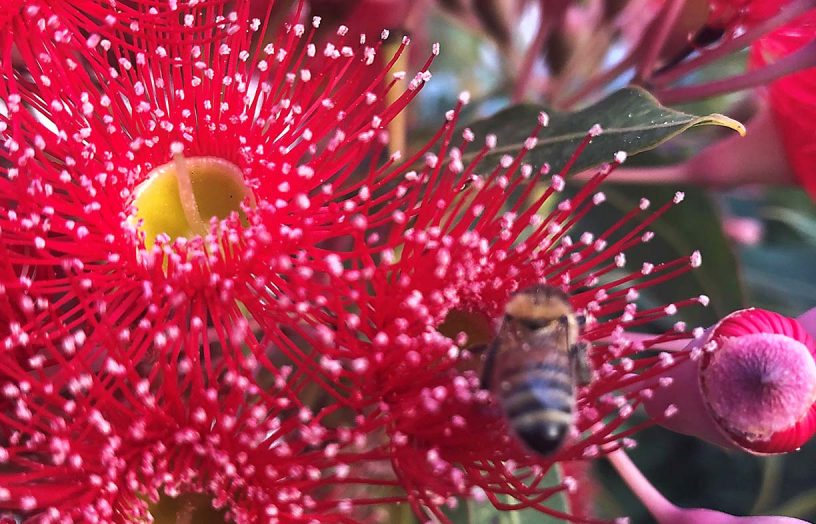 Water saving
Water saving
Nurturing your native garden
Just how much maintenance do you need in a native garden? Robyn Deed gets some tips from landscaper Haydn Barling on how to sustain a beautiful, biodiverse garden in the suburbs.
Read more gardening
gardening
Working with contours
Sarah Coles speaks to Guildford local Louise Balaz-Brown about gardening in tough conditions, the importance of contours and the miracle of sheep manure.
Read more

